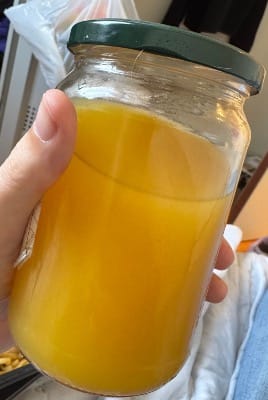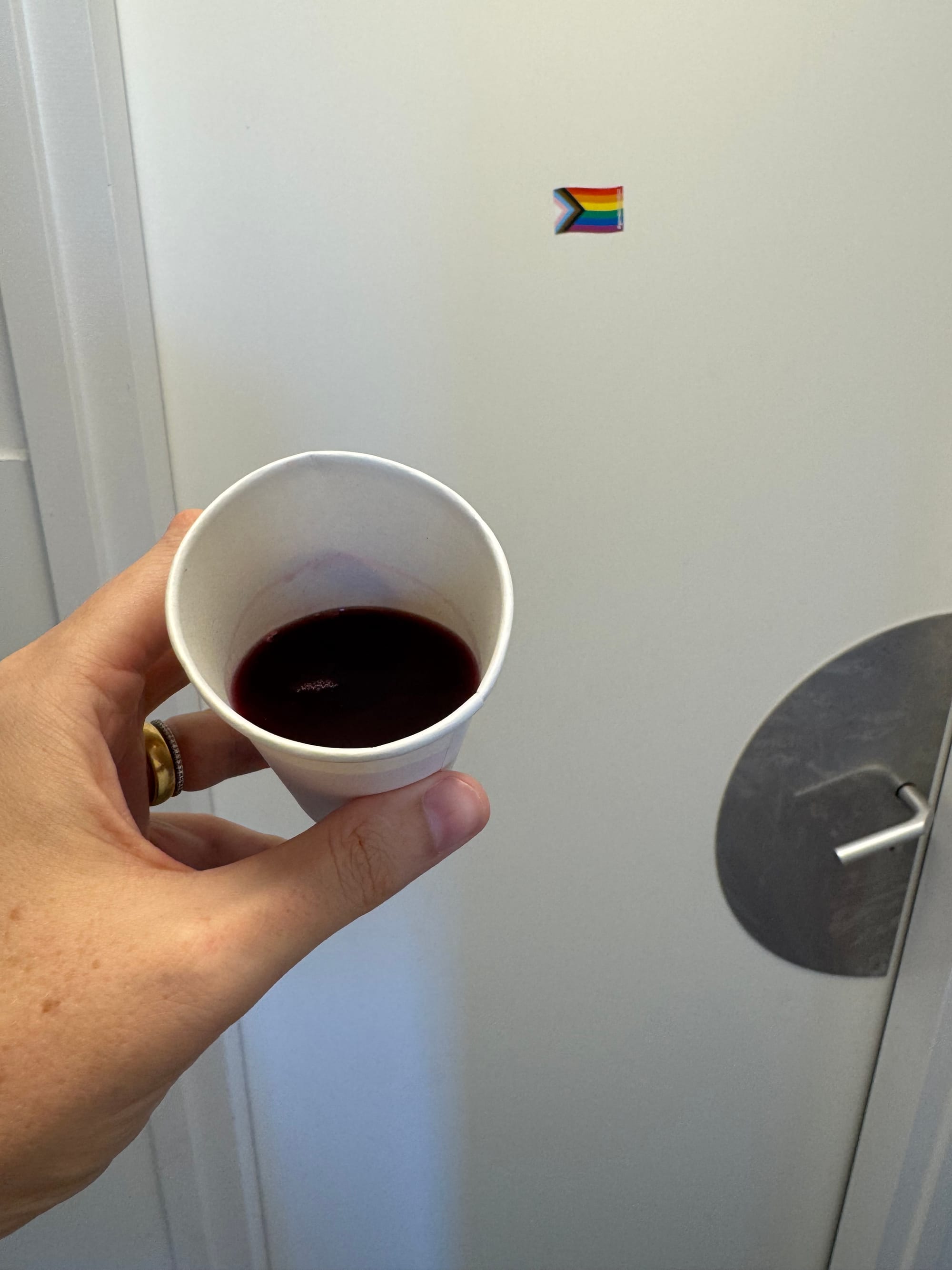fermentation with limited resources
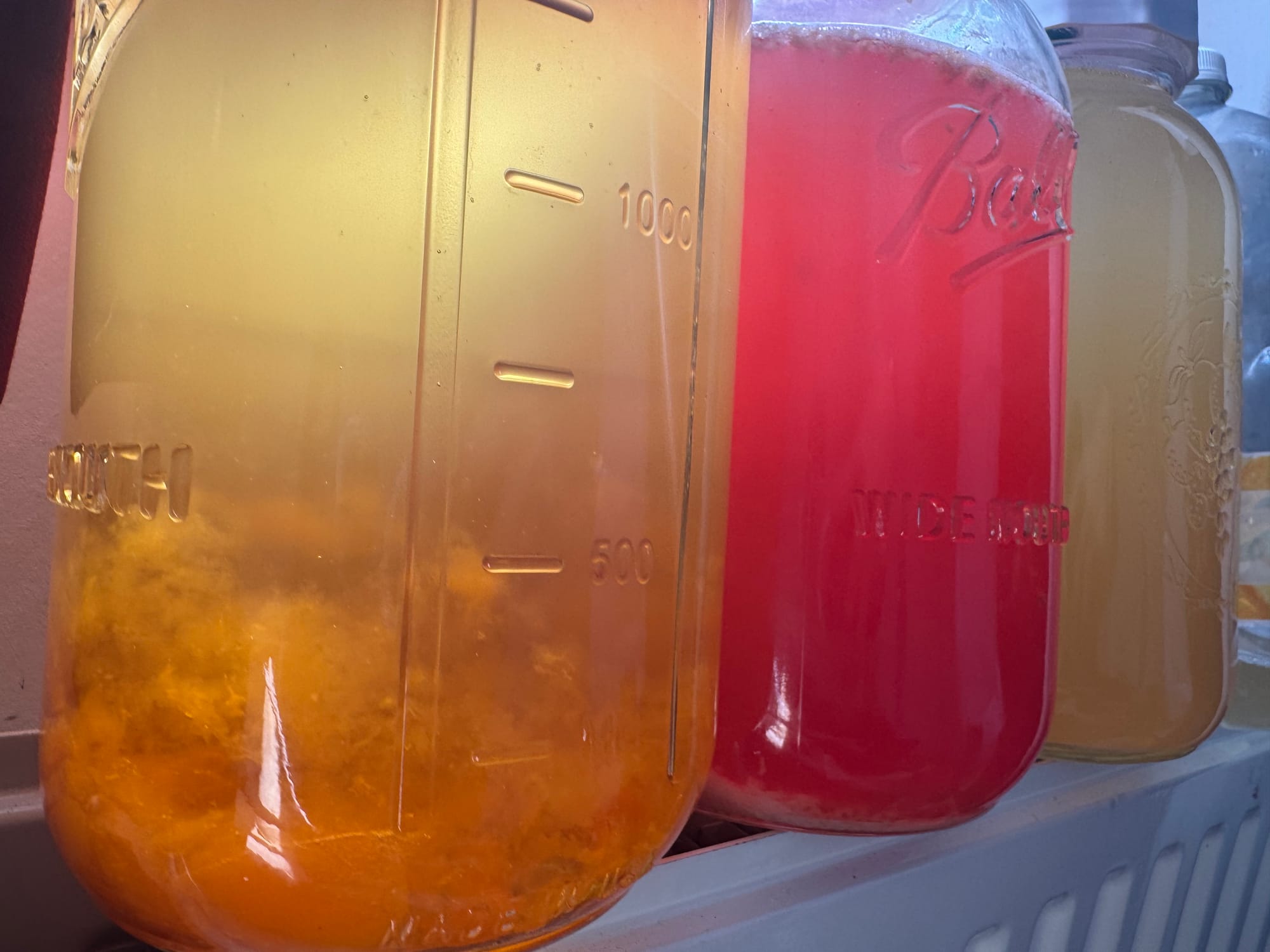
As I remember it, there was a poem titled Ketchup Wine that detailed how to make wine in prison from ketchup with the limited resources available to someone who is incarcerated. I remember reading about this a very long time ago, and I am not able to find the original source for this. Essentially, ketchup contains a lot of sugar per unit volume, and with very limited resources (essentially a vessel, a filter, water, and yeast) a pretty basic wine was possible.
A note on terminology in this document: when it comes to this kind of fermentation, words like wine, mead, cider, and so on, become kind of meaningless. So I may use them interchangeably and I may not "get it right," so please don't hassle me about this.
When I lived in California, I was a homebrewer. I didn't do this because I had some alcohol thing, I did it because I was on food stamps, and food stamps can't buy beer. It can, however, buy fruit juice and yeast. I was a very active swimmer, and one of the nice things about the club I swam out of is that we enjoyed beer in the shower and sauna. It was always cold in the SF bay, and when you get out, it's just very nice to have a beer in the shower. For my part, my stomach is very sensitive, and I need to eat when I come out of the water, and it's hard for me to eat potatoes, but I handle a beer pretty easily. I learned this on accident, but I don't think more details here are useful. Anyway, so I started making cider at home, with apple juice and yeast, then I started adding more ingredients (cinnamon, ginger, etc), and then I started using different bases, and my wine became much more technically complicated.
This required a lot of labor on my part, a lot of planning, and was very rewarding. It was a hobby, and it kept me busy. I was pretty sad knowing that I was going to be spending probably a lot of time at an AZC, and I was not going to have access to this hobby of mine anymore. But here we are, fifty-something days later, and we aren't allowed to work, and the diet here is pretty bland, and we're all going a little stir-crazy. I knew from my memory of "ketchup wine" that it was really easy to make wine from assorted common ingredients, and I knew that COA gave us basically everything (except yeast) to ferment, so I decided to resume my hobby primarily to keep me occupied.
I want to be clear and say that COA doesn't allow alcohol on site at AZCs, so I am not condoning anyone making alcohol this way. However, fermentation doesn't need to produce alcohol, and there are a lot of fermentation products that are very-low or no alcohol. One of these is what's called a "natural soda," which is essentially when you have allowed fermentation to start, but you don't let it progress long enough that you have a substantial proportion of alcohol. So what I am going to describe here is a handful of recipes for natural soda, in order from least complicated and expensive to more complicated and expensive.
Ingredients you get from COA
So you will probably have access to the following things from COA which can be used in fermentation:
- jams (apricot, cherry, strawberry, etc)
- honey (20g single-use packets)
- sugar (in single-use sachets for coffee)
- juice (primarily apple, but there's a variety, and apple is probably the most useful)
Additionally useful are tea bags which can be opened and used for filtration and the tea itself can be used to add tannin/astringent flavor to wine. You can sometimes get ahold of single packets of salt, and a very small amount of salt can be helpful with wine that is not otherwise very tasty.
What you will need that you can't get from COA
You will need to have some kind of larger vessel. If you want to go in to the Ter Apel Centrum, you can get 2L bottles of juice for about €3-4. This juice is not great quality, but it's pasteurized and doesn't have preservatives, so it's useful for the most basic soda/wine. And when you're done you can keep the bottle.
You will also probably want some kind of filter and funnel. You can use teabags, and it works, but they're very fine and it's slow. You can get a tea strainer from Amazon for a few euros. And you can use a ziplock bag as a funnel. I just cut the corner off of a bag, put the corner in the bottle, then strain into that with the tea strainer.
Yeast is kind of a problem, although you can get around this a couple of ways. First, you can do a wild ferment (I'll detail this below). Second, you can get baker's yeast, and it will work, from Omar market in Ter Apel, and you can get it at Jumbo and Aldi if you ask. Probably the best thing to do, if you're able to, is to buy yeast from Brouwland. I would personally suggest EC-1118 because it's a champ.
Easy "Rood" wine
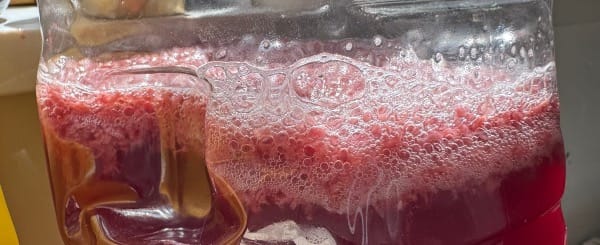

So there are these 2L bottles of juice at Jumbo (both Ter Apel and Emmen have them). The easiest way to turn these into a sparkling drink is to take about 1/4 of the bottle out, add some sugar (it's pretty difficult to measure your sugar dose here because you don't have a scale, but it's unlikely you have enough sugar to make it inhospitable for yeast), add your yeast dose, and just let the yeast do its thing. I found that this finished fermentation pretty quickly (= about one week). There are a couple reasons for this. First, when compared with larger fermentation vessels, the smaller volume means the yeast colonizes faster and ferments faster. Second, the only place I really have for my fermentation is on top of the radiator. I'm at Ter Apel in the early summer, so our radiator comes on at night, and the heat of the radiator substantially helps fermentation (note: this is not great for flavor, so you probably don't want to do this at home, but for making this at Ter Apel, it's fine).
Obviously fermentation produces carbon dioxide, so you'll need to burp the lid frequently. I just reach out over my head and unscrew it slightly until I hear it hiss, and gently close it again. If you're careful, you can leave the lid just closed enough that gas can escape (you'll hear a sizzling noise). This is ideal, because oxygen can lead to vinegar taste, and with the yeast creating a constant co2 pressure in the bottle, oxygen can't get in.
Congratulations, your room will probably smell like a brewery.
Cider

COA, thankfully, gives us a lot of apple juice (appelsap). This also has no preservatives, comes in a tetrapak, and is pasteurized, so you can just hoard the stuff, or trade it with your neighbors, and pretty soon, you've got enough apple juice to make cider or soda.
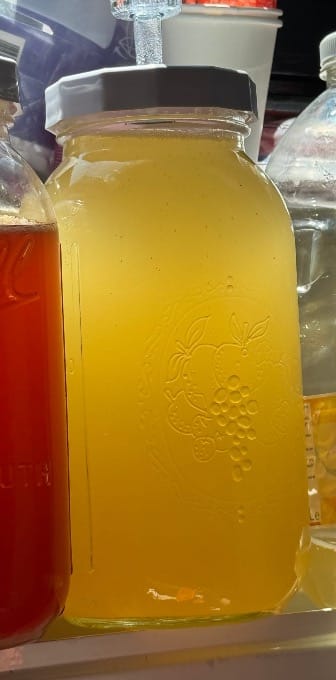
Because this recipe has a lot of sugar in it, I would really recommend you use proper glass and airlocks. You can get mason jars from Amazon NL, but it's kind of expensive vs getting them from Jampotten. I got my airlocks from Amazon, and they have a really nice kit. It's a little expensive, and there are plenty of alternatives, just make sure you check the diameter of the lid and the threads. Wide mouth mason jars are around 9cm diameter.
The way I would recommend doing this is start with 1L of a sugar wash: 500g of sugar, 1L of water. Make sure that's thoroughly dissolved, and then pitch your yeast into that. Give it a day or so to fully inoculate. This is extremely high osmolality, so you can expect the yeast to be pretty bummed out and not be vigorous. But that's to your advantage, because when you add the remaining liter (my jars are 2L, but you can just follow the ratio of 50-50 wash to juice), the yeast will immediately perk up and you'll get fermentation basically immediately. You can drink this in a day or two for a light, refreshing, summery drink or you can let it go longer and you'll get something closer to a chardonnay in dryness and it will be still. Because you're using just juice and water, this ferments extremely clean, and you hardly need to filter it. For something made from basically free ingredients, this is delightful.
Jam wine
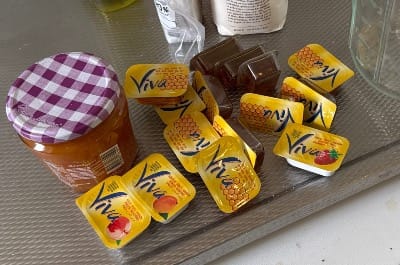
So, jam is essentially fruit that's been preserved with a very high sugar load, which increases its osmolality to the point that bacteria and wild yeast cannot survive. This is why it is shelf stable. However, if we add water to it, we reduce the osmolality, and we can then inoculate it with yeast, and fermentation is possible. Another benefit of this is that keeping fresh produce is quite difficult at the AZC, so starting with preserves/jam means you don't have to worry about spoilage. And because jam has a ton of sugar in it, you don't really even need to add sugar. You'd just add your jam to your fermentation vessel, add water, add yeast, and just let it go until you want to drink it.
Bonus: these Bonne Maman jars are pretty cheap (less than €5), there's a lot of different kinds of fruit available (more than you'd be able to get your hands on fresh), and when you're finished, you now have a 335ml jar you can drink from. Because, of course, we don't have any cups etc at the AZC. Slainte.

Wild ferment
I don't recommend this if you are inexperienced with fermentation. Essentially, you're allowing something to rot, and drinking it before it becomes harmful or tastes awful. Simply put, all fruit has yeast on the skin because it grew outside, and wild yeast is everywhere. So when we macerate fruit and add sugar (which isn't strictly necessary) and water, within a day or two, it's going to start bubbling, and this is your wild ferment. You do need to consume this quickly because it is rotting, but it can be quite tasty and refreshing.
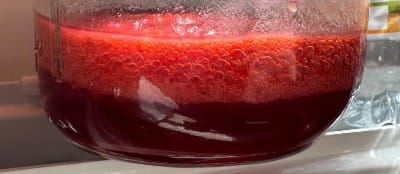
You'd just add water, give it at most 48 hours, and ta-da, you've got wild fermentation without yeast at all. You just let nature do its thing.
Mead
So, COA gives us honey pretty frequently, and honey has long been used in making wine, which is called mead.
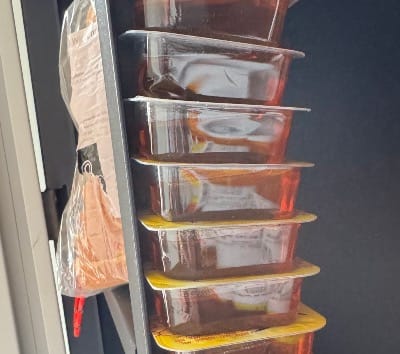
Honestly, the flavor from the honey COA gives us is not great, but it will work. One thing you have to keep in mind with honey is that it has a high osmolality, and it has lower sugar per unit mass than granulated sugar (perhaps obviously). So it is less efficient than using granulated, and you must add water (or juice, or whatever) or the yeast will not be able to survive. Because I do not have access to fresh fruit, what I have been using is jam. I start by adding 500g of honey (just about €3) and a full jar of jam in 1L of water. I make sure that's thoroughly dissolved, just by shaking the jar vigorously, and when everything is in solution, I then pitch the yeast, and then I add water to the jar to fill it the rest of the way. If you don't do this, there's a stratification that comes from the higher-viscosity stuff settling to the bottom. This means you can't ferment that stuff and it's got lots of flavor and lots of sugar. So your ferment is going to taste weird and you're going to waste sugar. Making sure everything is fully in solution before the fermentation starts means you won't have to stir or shake it later

Now because you're using jam, there's going to be a LOT of gunk in this and you're absolutely going to have to filter/strain it. You can strain this early if you want, because it's weird-looking, but it's better for flavor if you don't. Just don't open the lid (let the airlock do its job) and let the yeast finish. Mead is complicated and sometimes it's going to smell funny or look funny, so you probably don't want to mess with it until it's done.
Sour/lactoferment mead/wine
One of the things I miss from The Sycamore (my neighborhood bar back home) is getting a sour beer on a hot day. Beer is kind of hard to produce in this setting because I could possibly get my hands on hops, and there are even good reasons for this, but I don't really have the equipment to make beer. However, I have made a lot of kimchi in my life, and I know how to get sour in a ferment. So, like the wild ferment above, we're going to do that here. I started with pineapple and raspberry (both fresh, about €5 for both), macerated and added sugar. You may recognize the tray from the COA spaghetti. These are very useful to have around, so when you get spaghetti (pretty universally acknowledged to be the best food we get here), save the tray, clean it, and use it for stuff like this.

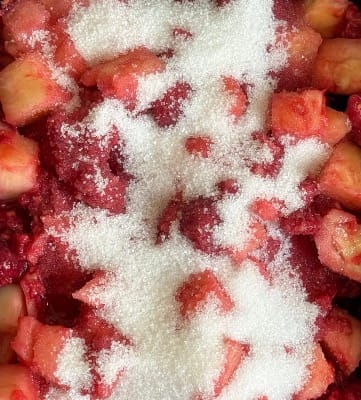


When this was starting to decompose (the sugar pulls moisture out of the fruit, so it starts to turn into sludge), I added two tablespoons of juice from fresh sauerkraut which I got from Jumbo for about €1.75. I then let this go another 36 hours, and it began to fizz, telling me that the kraut/lacto was doing its job. I then added 500g of honey and filled the rest of the jar with water. Now, technically this is mead because we're using honey, but there's also a lot of sugar in this, and we're also doing a lactofermentation step, which is definitely not mead, but we kind of don't have words for this.

I let this go until the yeast was obviously taking charge (remember there are two competing cultures in here, lactobacillus and Saccharomyces cerevisiae, and you really only want one working on your wine), then I pulled out the pulp. The reason I did this is it was continuing to sour, and I only wanted a hint of sour in my mead. Then I back-filled with water (remember to check that your water isn't gross; some of our water at Ter Apel is pretty gross) and let it do its thing. This is because there was enough sugar.
Don't do this.
One last thing worth mentioning: your refrigerator might be too cold. This is important because ethanol (the alcohol in wine) has a lower freezing point than water. If you notice that stuff is freezing solid in your freezer, this is a good thing for nefarious purposes. If you have one of these 2L plastic bottles, you can leave it on its side, let it freeze as much as you can, and then pour off the liquid part and discard the frozen part. This serves two purposes. The first is that it takes a lot of the "gunk" or off-flavors as well as the solids. The second is that it sequesters the water, and leaves the liquid part as higher alcohol content ("abv" or "proof"). This is definitely illegal and is a form of distillation, so please do not do it in your azc. Don't even do this in your home. But, if you're particularly brave and you don't mind higher abv, you can make something similar to brandy (this is called "applejack" or "freeze jacking" in America) in your refrigerator.
But again, please don't do this.
Cheers.
